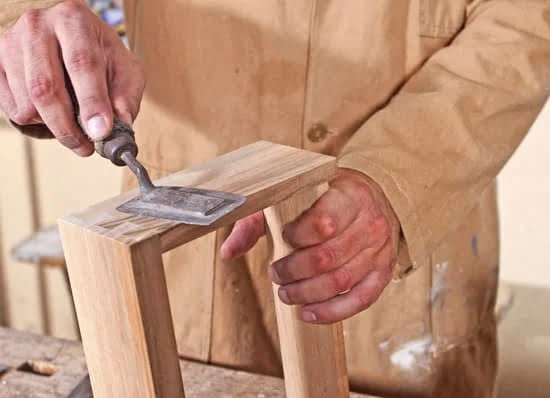What clamps do I need for woodworking? Clamps are a crucial tool in woodworking, providing the necessary stability and precision during various projects. Whether you’re assembling pieces of wood or gluing them together, having the right clamps is essential for a successful outcome. In this article, we will discuss the importance of clamps in woodworking and explore the different types of clamps commonly used in this craft.
Clamps play a vital role in ensuring that wood pieces are held securely in place during cutting, drilling, sanding, gluing, and assembly. Without the proper clamping tools, achieving accurate and professional results would be nearly impossible. As such, understanding the different types of clamps available and their specific uses is crucial for any woodworker.
In the following sections, we will delve into the details of bar clamps, C-clamps, pipe clamps, spring clamps, F-clamps, and specialty clamps. Each type of clamp comes with its unique features and advantages that cater to specific woodworking needs. By having a comprehensive understanding of these options, woodworkers can choose the right clamping tools for their projects with confidence.
Types of Clamps
When it comes to woodworking, having the right clamps for the job is essential for achieving secure and precise results. There are various types of clamps available, each with its own unique features and advantages. Understanding the different types of clamps commonly used in woodworking can help you choose the right ones for your specific project needs.
Below is a detailed overview of the different types of clamps commonly used in woodworking:
- Bar Clamps: These clamps are designed to hold large pieces of wood together, making them ideal for securing glued panels or laminates. They feature a long bar that provides ample clamping force and can be easily adjusted to accommodate different thicknesses of wood.
- C-Clamps: C-clamps are versatile and widely used in woodworking projects. They have a simple design with a fixed jaw and an adjustable screw mechanism that allows for easy tightening. These clamps are suitable for holding pieces together during gluing or securing a workpiece to a workbench.
- Pipe Clamps: Pipe clamps consist of a length of pipe with fixed jaws at one end and sliding jaws at the other end. They are known for their strength and versatility, making them suitable for both light-duty and heavy-duty projects. Pipe clamps are particularly useful for edge-gluing panels or securing large, irregularly shaped workpieces.
Understanding what clamps do i need for woodworking means knowing the specific uses and advantages of each type of clamp. By having a variety of clamps in your workshop, you can ensure that you have the right tool for any woodworking task that comes your way.
Bar Clamps
When using bar clamps, it is crucial to ensure that the jaws are properly aligned with the workpiece to evenly distribute pressure and prevent any damage. To use a bar clamp effectively, follow these steps:
- Position the workpiece: Place the two pieces of wood that need to be clamped together in the desired position.
- Adjust the clamp: Slide the moveable jaw along the bar to match the width of the workpiece. Make sure both jaws make contact with the surface of the wood.
- Tighten the clamp: Turn the handle clockwise to tighten the clamp until it holds the pieces securely in place.
One advantage of using bar clamps is their ability to exert significant pressure over a wide area, making them suitable for large-scale projects. Additionally, their adjustable nature allows them to accommodate various workpiece sizes and shapes, providing added flexibility during woodworking tasks. Whether you are gluing, assembling, or repairing, bar clamps provide the necessary support and stability for your woodworking ventures.
C-Clamps
When it comes to woodworking projects, having the right clamps is essential for securing pieces of wood together, holding them in place, and ensuring precision and stability. One type of clamp that is commonly used in woodworking is the C-clamp. These clamps are versatile and can be used for a wide range of applications in woodworking projects.
C-clamps are named for their shape, resembling the letter “C.” They consist of a simple frame with a screw mechanism that can be tightened or loosened to secure or release materials. These clamps are often used for holding wood pieces together while glue dries, securing objects to a work surface, or providing extra support during cutting or drilling.
The uses of C-clamps in woodworking are varied and numerous. From simple tasks such as holding pieces of wood together while joining them with screws or nails, to more complex applications like securing wood pieces at an angle for intricate cuts or joinery work, C-clamps are invaluable tools in any woodworker’s arsenal. Their sturdy construction and adjustable design make them suitable for a wide range of tasks, making them a must-have for any woodworking project.
| Uses | Applications |
|---|---|
| Holding wood pieces together | Joining with screws or nails |
| Securing objects to work surface | Providing support during cutting/drilling |
| Securing wood pieces at an angle | Intricate cuts/joinery work |
Pipe Clamps
One of the key advantages of pipe clamps is their ability to provide uniform pressure along the entire length of the clamp, ensuring even and secure attachment of wood pieces. This makes them ideal for glue-ups, laminations, and edge-to-edge joinery where consistent pressure is crucial for successful bonding. Additionally, their extendable nature allows for customization to fit varying project sizes, from small-scale crafts to larger furniture pieces.
In terms of strength, pipe clamps are known for their robust construction and durability. The use of steel pipes as the main component ensures that these clamps can withstand heavy loads without bending or flexing. This makes them particularly useful when working with hardwoods or when extra force is needed to bring two pieces together tightly. Overall, pipe clamps are a versatile and reliable choice for woodworking projects of all kinds.
| Advantages | Applications |
|---|---|
| Provides uniform pressure | Ideal for glue-ups, laminations, and edge-to-edge joinery |
| Robust construction | Useful when working with hardwoods or needing extra force |
For beginners just starting out in woodworking or those looking to expand their clamp collection, understanding what clamps they need for woodworking is crucial. This includes researching the different types available on the market and determining which ones will best suit their specific projects. Whether it’s bar clamps for larger pieces or specialty clamps for unique tasks, having a comprehensive selection will ensure that any woodworking endeavor is undertaken with precision and stability.
Ultimately, having a well-rounded collection of clamps will not only enhance the quality of woodworking projects but also provide greater flexibility in approaching different techniques and designs. By investing in reliable clamping tools such as pipe clamps, woodworkers can have confidence in achieving secure and professional results in their crafting endeavors.
Spring Clamps
One of the primary advantages of spring clamps is their ability to provide quick and easy pressure for temporary holding or securing tasks. Whether you need to keep a piece of wood steady while glue dries or hold two pieces together while fastening them with screws, spring clamps offer a reliable solution. Their compact size also makes them ideal for tight spaces or intricate woodworking projects where larger clamps may be impractical.
In addition to their practicality, another benefit of spring clamps is their affordability. Woodworking can be an expensive hobby or profession, so having access to cost-effective tools is crucial. Spring clamps are typically available at a relatively low cost, allowing woodworkers to stock up on multiple clamps without breaking the bank. This accessibility makes it easy for enthusiasts and professionals alike to have an ample supply of these handy tools on hand for various woodworking tasks.
Overall, when considering what clamps do I need for woodworking, it’s clear that spring clamps should not be overlooked. Their practical uses, ease of use, and affordability make them an indispensable tool in any woodworking workshop. Whether you’re working on small DIY projects or larger professional endeavors, having a collection of spring clamps at your disposal can greatly enhance the precision and stability of your workpieces.
F-Clamps
Features of F-Clamps
One of the key features of F-clamps is their adjustable nature, allowing woodworkers to easily modify the length of the clamp to suit their specific needs. This makes them ideal for working with materials of different thicknesses. Additionally, F-clamps have large flat pads on each jaw that help distribute pressure evenly across the workpiece, minimizing the risk of damage or marring.
Advantages of F-Clamps
The primary advantage of using F-clamps is their ability to provide strong and reliable clamping force. The design of these clamps enables woodworkers to exert significant pressure on the workpiece, ensuring a secure hold during various woodworking tasks. Furthermore, F-clamps are relatively easy to operate and adjust, making them suitable for both beginners and experienced craftsmen.
Applications in Woodworking Tasks
F-clamps are particularly useful when working with large pieces of wood that require steady and consistent pressure for gluing or assembly. They are also effective for securing materials in place while performing tasks such as sanding, drilling, or sawing. The adjustable nature of F-clamps makes them versatile for a wide range of woodworking projects, offering stability and precision in various applications.
Specialty Clamps
When it comes to woodworking, having the right clamps for the job is essential for achieving precision and stability in your projects. In addition to the standard clamps like bar clamps, C-clamps, pipe clamps, and spring clamps, there are also specialty clamps designed for specific woodworking needs. These specialized clamps offer unique features and advantages that can make certain tasks much easier and more efficient.
Pocket Hole Clamps
One type of specialty clamp that is commonly used in woodworking is the pocket hole clamp. These clamps are designed specifically for use with pocket hole joinery, which involves creating strong joints between pieces of wood using pocket screws. Pocket hole clamps are used to hold the pieces of wood together at a precise angle while you drive in the pocket screws, ensuring a tight and secure joint.
Edge Clamps
Edge clamps are another specialized type of clamp that is ideal for holding pieces of wood together along their edges. These clamps have adjustable jaws that can be tightened to secure the wood firmly in place while glue or fasteners are applied. Edge clamps are particularly useful for edge joining boards to create wider panels or laminating multiple layers of wood together.
Frame Clamps
For woodworking projects involving frames or boxes, frame clamps are an essential tool. These clamps are designed to hold four pieces of wood securely in place at perfect right angles, allowing you to assemble frames with ease and accuracy. Whether you’re building a picture frame or a cabinet box, frame clamps can simplify the assembly process and ensure that your corners are perfectly square.
By understanding the different types of specialty clamps available for woodworking, you can ensure that you have the right tools on hand for any project. From pocket hole clamps to edge clamps and frame clamps, these specialized tools offer unique features and advantages that can streamline your woodworking tasks and help you achieve professional results.
Conclusion
In conclusion, the importance of having the right clamps for woodworking cannot be overstated. The variety of clamps available in the market cater to different needs and preferences, allowing woodworkers to achieve precision and stability in their projects. It is crucial to understand the specific uses and advantages of each type of clamp in order to make informed decisions when selecting the appropriate clamps for various woodworking tasks.
From bar clamps to pipe clamps, C-clamps to F-clamps, woodworkers have a wide range of options to choose from depending on the size and nature of their project. Each type of clamp offers unique benefits, such as holding large pieces of wood together securely (bar clamps), providing strong and versatile support (pipe clamps), or offering quick and convenient one-handed operation (spring clamps).
Ultimately, investing in a variety of essential clamps will not only enhance the quality and precision of woodworking projects but also make the woodworking process more efficient and enjoyable. Understanding what clamps do i need for woodworking is an essential aspect of being a successful woodworker, as it ensures that one can tackle any project with confidence and skill.
Frequently Asked Questions
What Clamps Should a Woodworker Have?
A woodworker should have a variety of clamps in their toolkit, including C-clamps, bar clamps, pipe clamps, and spring clamps. Each type of clamp serves a different purpose in woodworking projects.
How Many Clamps Do You Need for Woodworking?
The number of clamps needed for woodworking can vary depending on the size and complexity of the projects being undertaken. It’s generally recommended to have a mix of different types and sizes of clamps to handle various tasks effectively.
How Do I Choose a Wood Clamp?
When choosing a wood clamp, consider the size and weight capacity needed for your projects. Look for durable construction and smooth operation, as well as ease of use and adjustability. Additionally, consider getting a few different types of clamps to cover a range of woodworking needs.

Hi everyone! I’m a woodworker and blogger, and this is my woodworking blog. In my blog, I share tips and tricks for woodworkers of all skill levels, as well as project ideas that you can try yourself.





